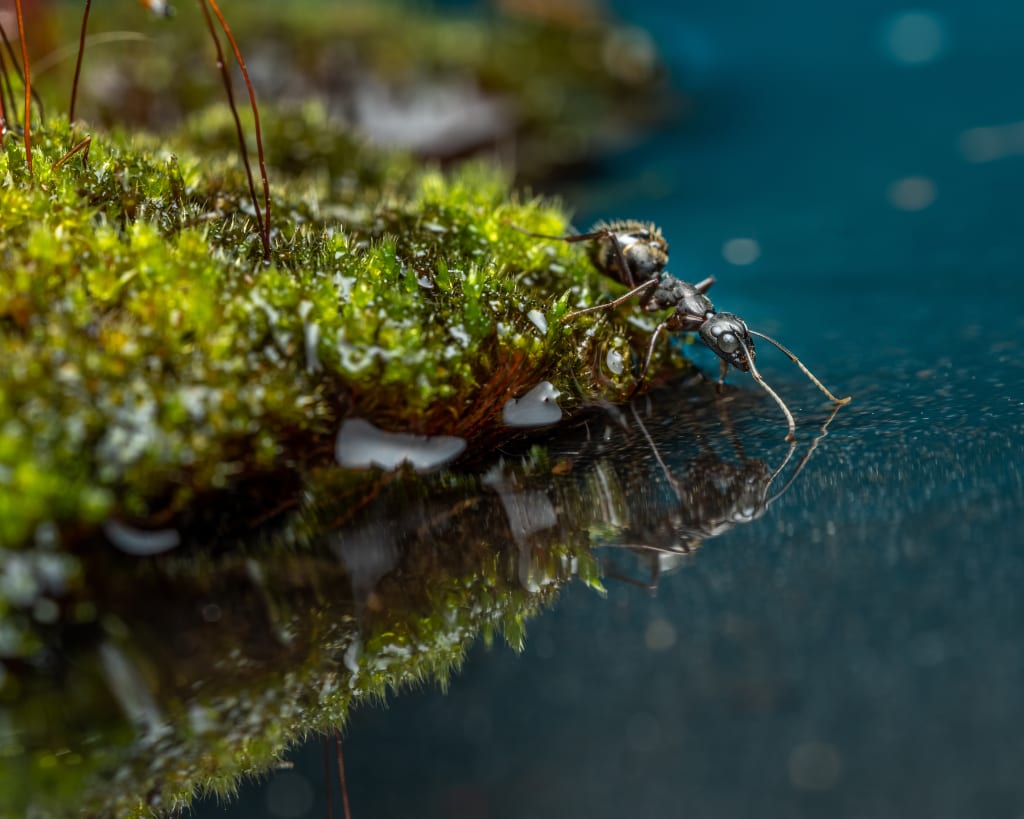Water-Gliding Ants
How These Remarkable Insects Survive Weeks Underwater

Ants are some of the most remarkable creatures on the planet, with a wide range of adaptations that allow them to thrive in diverse environments. One such adaptation is the ability of certain species of ants to survive underwater for extended periods. In this article, we will explore the fascinating world of underwater ants, focusing on the remarkable abilities of one species in particular: the water-gliding ant.
Water-gliding ants are a species of ant found in Southeast Asia, where they live in and around rivers, streams, and other bodies of water. Unlike most ants, which avoid water at all costs, water-gliding ants are highly adapted to aquatic environments. They have long, slender bodies and legs that allow them to move easily across the surface of the water, much like a water strider.
However, what is perhaps most remarkable about water-gliding ants is their ability to survive for extended periods underwater. While most ants would drown within a matter of minutes if submerged in water, water-gliding ants can hold their breath and survive for weeks at a time.
Scientists have been studying the remarkable abilities of water-gliding ants for years and have discovered that these ants have several unique adaptations that allow them to survive underwater. One of these adaptations is the presence of tiny hairs on their bodies that trap air bubbles, creating a pocket of air that the ants can breathe from while submerged.
In addition, water-gliding ants have been observed building underwater nests, which they construct by weaving together pieces of plant material and other debris. These nests provide the ants with a safe and dry space to rest and store food and allow them to survive for extended periods underwater.
The ability of water-gliding ants to survive underwater has important implications for our understanding of the evolution of ants and other insects. It is also an important reminder of the incredible diversity and adaptability of life on Earth and the remarkable ways in which different species have evolved to survive and thrive in their respective environments.
Despite the fascinating nature of water-gliding ants, there is still much that remains unknown about these remarkable creatures. For example, scientists are still trying to determine exactly how long these ants can survive underwater, and what factors influence their ability to do so.

In addition, researchers are interested in studying the potential applications of the water-gliding ant's adaptations for human technology. For example, the ability to trap air bubbles on their bodies could have applications in creating more efficient underwater vehicles or even new types of scuba gear.
As our understanding of the water-gliding ant and its remarkable adaptations continues to grow, it is clear that these creatures have much to teach us about the incredible diversity and adaptability of life on Earth. They serve as a reminder of the ongoing mysteries and wonders of the natural world, and the important role that scientific inquiry plays in uncovering its secrets.
So the next time you see an ant scurrying across your kitchen counter or marching in a long line across your backyard, take a moment to appreciate the incredible complexity and diversity of these tiny creatures. And if you happen to come across a water-gliding ant, take a moment to marvel at its remarkable ability to survive and thrive in an environment that would be deadly to most other insects.
One particularly interesting study, published in the journal Proceedings of the National Academy of Sciences, examined the physical mechanisms that allow these ants to move across the surface of water.
The study found that water-gliding ants can "trap" air bubbles on their bodies through a combination of surface tension and hydrophobic (water-repelling) hairs on their legs and bodies. These trapped air bubbles create a thin layer of air around the ant's body, allowing it to move across the water's surface without breaking the surface tension.
This remarkable adaptation allows water-gliding ants to access new food sources and escape predators that would otherwise be inaccessible or deadly. However, it also presents new challenges for scientists studying these creatures, as they must find ways to observe their behavior and physiology both above and below the water's surface.

In recent years, researchers have begun to use advanced imaging techniques such as X-ray microscopy and 3D imaging to study the internal anatomy and physiology of water-gliding ants. These techniques have revealed new insights into the mechanisms underlying the ant's water-gliding abilities and have helped scientists better understand the evolutionary history of these adaptations.
As our understanding of water-gliding ants and their adaptations continues to grow, we may uncover new insights into the fundamental processes that govern life on Earth. From the molecular mechanisms that allow an ant to trap air bubbles on its body, to the larger ecological and evolutionary implications of these adaptations, there is much still to be learned from these fascinating creatures.
In conclusion, the water-gliding ant is a truly remarkable creature, with a unique set of adaptations that allow it to survive and thrive in aquatic environments. Its ability to survive underwater for weeks at a time is a testament to the incredible diversity of life on our planet, and a reminder of the remarkable ways in which different species have adapted to their environments over millions of years of evolution.
Thanks a lot for reading! Do well to like as well!
About the Creator
Derick Okwa
I am a fun and easing going guy who loves nature and the beautiful creatures inhabiting the earth with us. More reason I write articles about them.






Comments
There are no comments for this story
Be the first to respond and start the conversation.